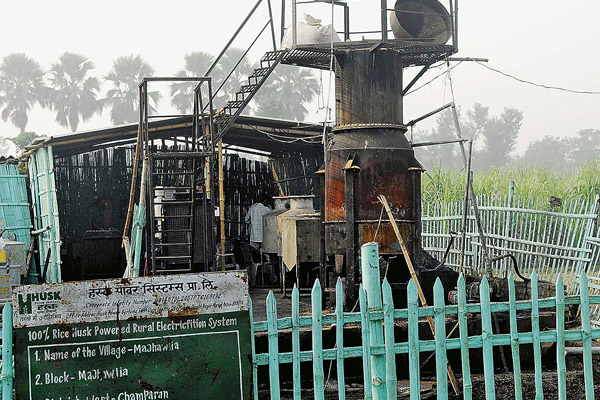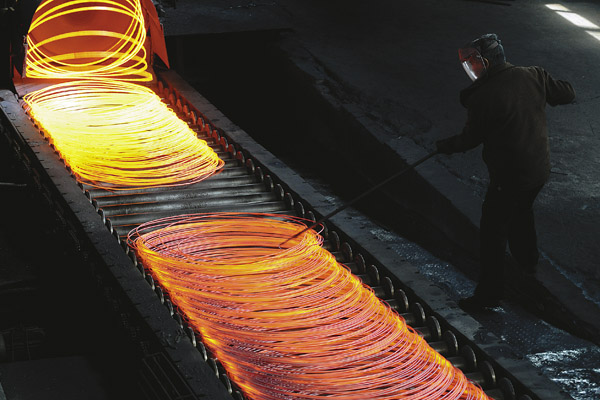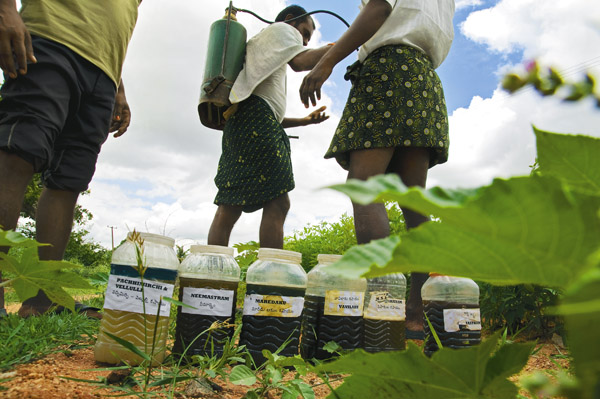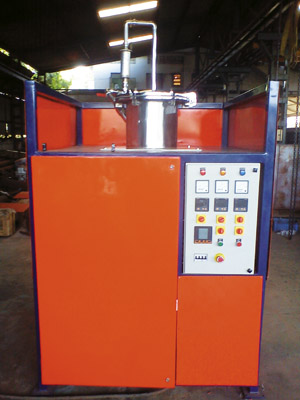
Eco-Success Stories
A selection of ideas and projects that are helping fight climate change
Soot Pursuit
Replacing traditional stoves with clean-burning stoves can reduce CO2 emissions
By Dinesh Narayanan
The World Health Organisation estimates that indoor pollution from inefficient burning of biomass fuels kills about two million people every year. Not just that, Veerabhadran Ramanathan, professor of Atmospheric and Climate Sciences, Scripps Institution of Oceanography, University of California, San Diego, has proven that soot from cooking plays a key role in climate change.
Ramanathan’s research using unmanned aerial vehicles discovered the Atmospheric Brown Cloud (earlier called Asian Brown Cloud), a familiar haze that engulfs the Gangetic plains on the Indian subcontinent and beyond, especially during the winter months. Soot from cooking was primarily responsible for that.
Ramanathan, together with the Delhi-based TERI, embarked on a pilot study of 30 households to measure soot generation in rural kitchens using censors attached to cell phones. The simple device measures, records and transmits the data to the scientists’ computers. Later this year, the project—called Project Surya—will move to the demonstration stage where about 10,000 households spread over approximately 100 square km in the Jagdishpur block of Sultanpur district of Uttar Pradesh will be supplied with clean-burning stoves developed by TERI. The aim is to show a hole in the brown cloud where soot generation is minimal.
The stoves, which use fans to improve oxygen supply to burn fuel better and reduce pollution by a factor of five, however, are not restricted to the experiment. TERI is in talks with local stakeholders such as regional rural banks, microfinance institutions, manufacturers and marketers to finance and popularise the stoves all over the country.
Another upshot is that since soot reduction can be measured and data generated on a real time basis, stove users can claim carbon credits. That means the millions of rural users would not only be able to recover the cost of the stoves (Rs 800-Rs 3,000), but also may generate some extra income.
Little Dynamos
Micro-grid projects are using locally available resources to bring electricity to hundreds of villages
By Dinesh Narayanan

Mera Gao Power (MGP), a small, Uttar Pradesh-based start-up, is hoping to do what India’s state-backed power utilities have not been able to: Light a couple of lamps in rural homes. To boot, MGP is supplying clean power generated from solar energy.
Started by Americans Nikhil Jaisinghani and Brian Shaad, the company’s operation is simple. It creates a micro-grid by setting up a solar unit just big enough to supply DC power to about 35 homes to light two LED lamps and a mobile phone charging point. It costs the user Rs 25 per week and Rs 40 in installation charges.
Such micro-grids are coming up all over the country, giving hope to about 40 crore Indians who are not connected to the woefully inadequate national grid. “I have no doubt that renewable energy-based micro-grids have great potential,’’ says IH Rehman, director for social transformation at The Energy and Resources Institute (TERI).
While enterprising folks in some parts had earlier hooked up homes to diesel generators, the new start-ups are looking at ways to utilise locally suitable sources such as wind, sun and bio-mass to harness energy.
Husk Power, which started operations five years ago now runs 90 power plants supplying electricity to 45,000 households. Each plant, which produces power from abundantly available rice husk, helps replace 42,000 litres of kerosene and 18,000 litres of diesel, sequestering 150 tonnes of carbon dioxide per unit every year.
While many such power-producing units supply power only for basic needs, other players are entering the market. SunEdison, a California-based company is setting up a solar micro-grid project in Madhya Pradesh. Though these are early days, micro-grid projects are likely to proliferate in India’s rural areas, helping reduce dependence on fossil fuels and cutting carbon emissions.
The Waterway to Low Cost
Steel companies like Essar have reduced costs by saving or reusing water
By Prince Mathews Thomas

CIRCLE OF COST Some Indian companies like Tata Steel and Essar Steel have brought their water consumption down to the global average of 5-10 cubic metres from the Indian average of 10-80 cubic metres per tonne of steel
Iron ore and coal might be the two most essential raw materials to make steel. But there is a third one that is almost equally important—water. The atomic mix of hydrogen and oxygen is used to cool hot, molten iron, which might otherwise take too long to lose its heat. But in a country where per capital availability of water has fallen by 60 percent, it is criminal that the local steel industry is quite lax in using this precious source. According to a study done by Centre for Science and Environment, Indian steelmakers, on an average, use 10 to 80 cubic metre of water for making a tonne of steel. The global standard is five to 10 cubic metres.
A few steel companies though, have tried to make a difference. This includes Tata Steel and Essar Steel. Tata Steel has reduced water consumption by more than 70 percent since the turn of the millennium, easing pressure on Jamshedpur’s strained resources.
Essar Steel too has managed to meet global standard in water usage. The Hazira, Gujarat-based steel maker uses 2.06 cubic metre of water per tonne of steel. “This is much below the norms prescribed under corporate responsibility for environment protection, which sets the limit at eight cubic metres per tonne,” says Dilip Oommen, CEO & MD, Essar Steel India.
The company launched a water policy in 2008, after which a ‘water cell’ was formed. The cell consists of 30 executives who conduct water audits, including daily review of consumption. The company’s engineers also found a way to reuse the effluent flowing from the captive power plant in the steelmaking process. Last year, the company saved almost 5 million cubic metres of water by reusing this effluent in its steel mill, which is equal to the annual water requirement of almost 5,000 Indians. Essar Steel saved another two million cubic metres of water by conserving rainwater.
Apart from sharing this learning with other companies in the Essar Group, the steel maker is exchanging notes on water management with its other peers in the industry including Steel Authority of India Limited and Tata Steel.
Green Debentures
The Natural Capital Declaration will encourage financial institutions to consider environmental, social and governmental factors while making an investment
By Prince Mathews Thomas
Companies may not give much heed to non-governmental organisations, or NGOs asking them to adopt sustainable development as a business model. But what if banks and other financial institutions, from which the same companies borrow money, insist they go green? Even if unwillingly, companies might be forced to act.
That is the impact that could possibly come out of Natural Capital Declaration, or NCD, says its founder Ivo Mulder, who is also Programme Officer at United Nations Environment Programme’s Finance Initiative.
To quote from its official website, “The Natural Capital Declaration is a statement by and for the financial sector… to work towards integrating natural capital considerations into lending, investment and insurance products and services.” A “natural capital” could include environmental, social and governmental factors.
The Declaration will be launched just ahead of the UN Conference on Sustainable Development, or Rio+20 in June later this year.
With a month to go, already about 25 multinational financial institutions have signed up as signatories of the Declaration. This includes well-known names like the Rabobank Group, Standard Chartered and National Australia Bank.
As Mulder explains, the Declaration works in a few steps. First, it will enable its signatory financial institutions to understand how their clients depend on natural resources. Benchmarks have already been set for three sectors such as pharmacy and extractives, which include mining.
Second, the Declaration will ask its members to embed the principles in their services and products. So while evaluating a value of a company, banks will factor in its exposure and responsibility towards a natural resource/capital. Lastly, once a bank becomes a signatory, it will have to be open to “annual and public” accounting of its performance along the Declaration principles.
“As a signatory of the NCD, it might help to improve the perception of the company,” says Lara Yacob, Senior Engagement Specialist Responsible Investing, Robeco. “But the perception or the brand of the company is only as good as what it does on the ground,” she adds. Yacob says the company is making sure that it is walking the talk. Like its parent Rabobank, Robeco is also an advocate of responsible investing. Rabobank was in news couple of years after it pulled out millions of dollars out of hedge funds who lacked transparency. Observers point out that in future, rating by a Standard & Poor or a Fitch might factor in companies’ performance on Natural Capital parameters.
Interestingly, none of the banks or other financial institutions from India has yet shown any signs of interest in NCD.
Waste not, Want Not
T Raghavendra Rao’s company STEPS is going places with its waste-to-fuel technology. Could this be the future for India’s 1.2 million tonnes-a-day of solid waste?
By Seema Singh
For years, T Raghavendra Rao managed waste, conducted bioremediation and recovered oil from tank beds at practically every public sector oil refinery in the country. So, when he decided to start on his own, plastic was the inevitable corollary.
In 2007, Rao set up Sustainable Technologies and Environmental Projects (STEPS) in Mumbai to develop a proprietary catalyst that converted plastic into a mix of liquid fuel, gas and coke. In five years since then, STEPS has signed half a dozen agreements for setting up waste-to-fuel plants overseas and refined its Polycrack technology to process a variety of waste products—from plastics to rubber to solid municipal waste. Mumbai alone produces at least 6,000 tonnes of municipal waste in a day.
Using its Polycrack process, a plant using 1,000 tonnes of waste can typically produce 120 tonnes of oil, 100 tonnes of highly combustible gas (which is used to run the plant), 500 tonnes of high calorific carbon, 50 tonnes of pebbles, and waste water (which is used for cooling purposes). In sum, it’s a zero-waste, self-contained process that most municipalities would like to use for managing over 1.2 million tonnes of solid waste that India generates every day.
It’s no rocket science, but a robust technology combined with the crucial catalyst system which is capable of producing real high quality oil that can be easily split into kerosene, gasoline, diesel, and heating oil fractions, says Jelle Frölich, a technical director at the waste management company PTF Ltd, which is building a plant in Rotterdam, Netherlands. “In addition, there are firm contacts and business cases projected in Belgium, Germany, Spain, and in the Caribbean.”
Rao, who was slow in commercialising the technology as he wanted to secure his intellectual property, is now setting up a 150 tonnes/day plant near the Mumbai-Nashik highway. He says STEPS is now reaching out to municipalities in India. The company has been a three-time winner of the India Innovation Growth Programme run by the Department of Science and Technology, India, and American aerospace, security and advanced technology company Lockheed Martin. It claims the fuel obtained through Polycrack meets standards set by international standards organisation, ASTM International, which are accepted across industries. “Dumping [waste] into landfills or composting hasn’t proved environmentally friendly,” says Rao. Perhaps, his zero-discharge technology will prove otherwise.
Growing Green
An eco-friendly farming experiment that began in Andhra Pradesh is spreading to other states
By NS Ramnath

NATURE’S SPRAY Farmers using nature-friendly pesticides in Kurnool, Andhra Pradesh
Sometime in 2004, Punukula, a sleepy village in the Khammam district of Andhra Pradesh shot into national fame after it banned synthetic pesticides. By then, all the farmers there had adopted a chemical pesticide-free cultivation method, and saw their input costs and debts come down, and incomes go up. In a state prone to input-intensive agriculture—it spends five percentage points above national average on pesticides and fertilisers—the success of Punukula was seen as a freak incident that would be too difficult to replicate or scale up.
A programme called Community Managed Sustainable Agriculture (CMSA) proved that pessimism was misplaced. Started in the same year, it initially covered about 400 acres in 12 villages in AP and quickly grew to 1.3 million acres by 2009. It has doubled since then, says T Vijay Kumar, a joint secretary in the union rural affairs ministry. CMSA used self-help groups in the state to persuade women to use locally available resources such as cow dung, cow urine and gram flour instead of synthetic pesticides fertilisers and move towards sustainable, eco-friendly agriculture. Costs came down by a third, and many got rid of debts.
Impressed by its success, several agencies have been studying this model to replicate it nationally, and have made some progress in parts of Bihar, Kerala and Tamil Nadu. Jawaharlal Nehru University’s Himanshu says attempts to replicate what has been successful in one region doesn’t always meet with success in other regions because of cultural and historical factors. What works in Kerala might not work in UP, he says.
Vijay Kumar agrees. In Bihar, the model needs to adapt to small land holdings; in Kerala there’s better scope for collective farming; chemical pesticides cannot be completely done away with everywhere and so on. Still, there are common lessons, and the most important of them all is the role played by the local community and grass root institutions. Without active local institutions, nothing much can be achieved, and our focus now is on identifying them, supporting them, and helping them to work together, he says.
(This story appears in the 22 June, 2012 issue of Forbes India. To visit our Archives, click here.)
Post Your Comment
















